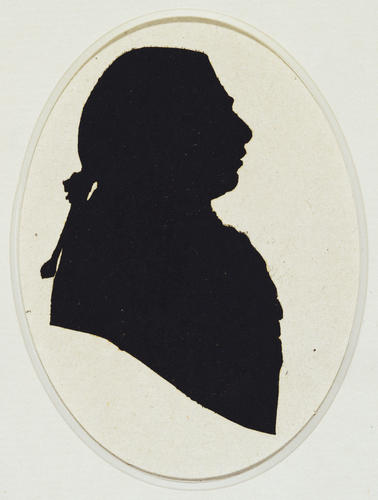-
1 of 253523 objects
Attributed to Lind, James (1736-1812)
Silhouette of George III dated Jan 1792
Monoprint | 11.5 x 7.8 cm (sheet of paper) | RCIN 1047678.am
-
A monoprint silhouette showing George III, facing right in profile.
This printed silhouette belonged to Sir Joseph Banks’s wife, to whom it was probably given by either Lind or Cavallo. Both were Fellows of the Royal Society, of which Lady Banks’s husband was President from 1778. Other profiles by Lind and Cavallo are in the Banks collection in the British Museum.
Dr Lind, a physician to the royal family, settled in Windsor c.1777. In addition to his professional practice, he had a printing press at Windsor and his scientific experiments and ‘tricks’ were well known. (Among the miscellaneous tasks entrusted to Lind by the King, in January 1782, was the planting of a cabbage garden at Windsor, in which hares - used for the royal sport - would be protected during snowy weather) Cavallo, the son of a Neapolitan physician, was likewise a scientist with wide-ranging interests - including ballooning. Both Lind and Cavallo were present on the North Terrace, Windsor Castle, on the evening of 18 August 1783, with their friend Thomas Sandby who depicted the group witnessing a meteor flying overhead. In the early 1790s Lind and Cavallo engaged in a lively (if somewhat surprising) correspondence on the subject of portrait silhouette-making. The two men worked as partners on their silhouettes: Lind would take the likeness at full scale, before sending it to Cavallo for reduction and recutting. The Royal Collection includes a number of other silhouettes which resulted from the partnership. These are contained in two volumes of silhouettes acquired in 1944 from Miss Violet Gosset, a descendant of Dr Lind . The first two silhouettes in volume I are of the King and Queen and are identical to the present subject. This silhouette of the Queen is inscribed C and the fact that it is dated 1788, while that from Miss Banks’s album is dated 1792, demonstrates that silhouette likenesses were reused over a number of years.
The portrait of the Queen recorded here would appear to date from the 1770s or early 1780s. Monoprints were produced by dipping a silhouette - cut from stiff card - into oil-based ink, and then sandwiching the inked card between two pieces of paper; a pair of impressions from the card - one a mirror image of the other - would thus be obtained.
Verso inscribed: (January 1792)
Catalogue entry adapted from George III & Queen Charlotte: Patronage, Collecting and Court Taste, London, 2004 -
Creator(s)
-
Medium and techniques
Monoprint
Measurements
11.5 x 7.8 cm (sheet of paper)
Category
Object type(s)
